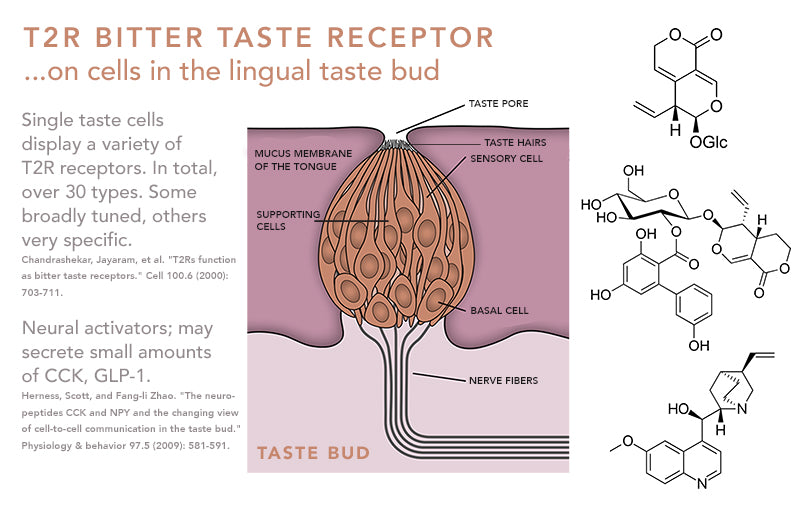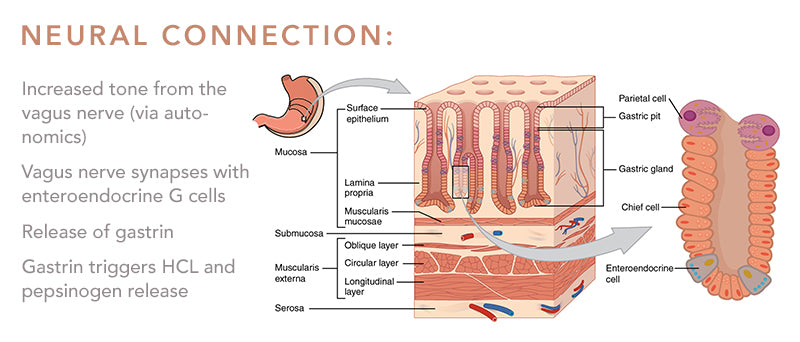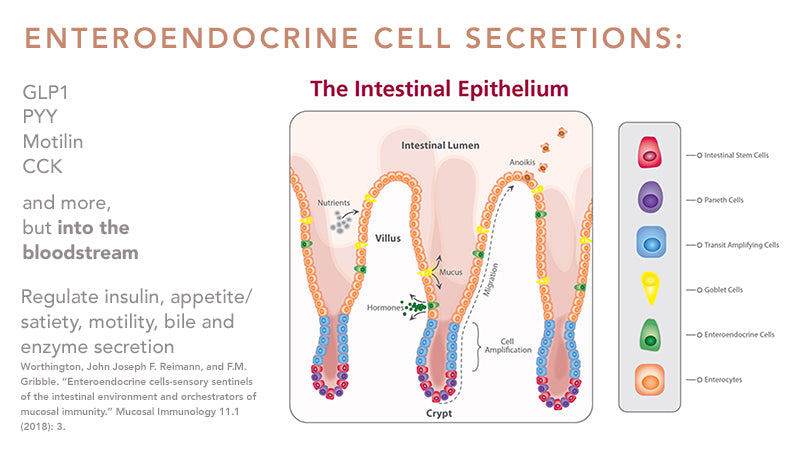We take digestion for granted, but it's not an easy task: we consume a range of foods, at different times, under changing circumstances. Balancing all these variables, our guts distil macronutrients (proteins, fats and carbs) and process micronutrients and phytochemicals. For this feat, we rely on our digestive juices, secreted into the hollow inner spaces of our digestive organs by specialized glands.
Digestive juices are complex and can contain digestive enzymes, acids and pH regulators, water, electrolytes, immune-active antibodies, lubricants, protective gels, and a lot more. This content is not uniform: at any given time, and in different places along the GI tract, different components are secreted in different proportions, taking into account what type of food we've eaten. The purpose of the digestive juices, however, remains the same throughout: smooth chemical breakdown of food to prime the body for optimal absorption and good nutrition. To this end, our physiology uses a signal network of nerves and hormones to coordinate everything from appetite, to the rate of movement and churning in the GI tract, to the secretion of digestive juices. What current research is discovering, and what herbalists have always known, is that bitter flavors have a special role to play in this signal network, triggering its activity and inspiring the production of digestive juices across the entire gut. How does this happen? Researchers focus on bitter herbs like gentian, and bitter-tasting molecules, to gain some insight. In these cases, our bodies' bitter taste receptors seem to be the bridge between the bitter flavor of these molecules and their supportive benefits. Let's take a closer look.

|
|
This file is made available under the Creative Commons CC0 1.0 Universal Public Domain Dedication. |
In the mouth, bitter taste receptors (broadly known as T2R receptors) are found on cells all across the tongue 1. These cells are connected to nerve endings (from two cranial nerves, the glossopharyngeal nerve and the facial nerve) 2 that relay the bitter sensation first to the brainstem (a specific area known as the solitary tract nucleus) 3. Here, a reflex "bounce" sends the signal right back to the salivary gland, and digestive juice secretion begins 4. Salivary secretions, like all digestive juices, are rich and complex. We find amylase, an important enzyme responsible for breaking down starches into simple sugars so, later on, they are less likely to ferment and cause gas (try chewing bread or grains for 30 seconds or so and notice the sweet taste as it develops). But the salivary glands also produce bicarbonate, to keep the mouth's pH alkaline, and protective proteins that strengthen tooth enamel. Finally, saliva is loaded with immunoglobulin-A, an antibody that provides a first line of defense 5. Try some bitter-tasting plants like gentian or wormwood, and notice how you start to salivate 6. By working with the body, the perception of the bitter flavor helps deliver a whole lot more than just the enzyme amylase.
The activity of bitter taste receptors on the tongue doesn't stop there, though. Remember that signal going to the brainstem? Yes, the reflex "bounce" triggers salivation right away. But the nerve signal continues past the brainstem to the structures of the limbic system, including the thalamus and hypothalamus 7. These important brain centers coordinate the function of our internal organs, and digestive organs are no exception. When the bitter taste sensation arrives there, another signal travels out of the hypothalamus on the vagus nerve and touches off the production of digestive juices in the stomach, pancreas, and liver. Within a few seconds of tasting an herb like gentian, this signal from the vagus nerve starts activating the production of pepsin (a proteolytic enzyme in the stomach), pancreatic digestive enzymes (including amylases, proteases, and lipases), and bile secreted from the liver and stored in the gall bladder 8. The whole gut is coming online. Bring on the food!
Those cells on the tongue where we find bitter taste receptors have another trick up their sleeve, one which becomes more and more of a feature as we move along the rest of the GI tract. In response to bitter-tasting molecules (researchers often use molecules like quinine or denatonium), these cells don't just send out a nerve signal. They also produce trace quantities of important hormones, which go right into the bloodstream and are distributed widely 9. These include cholecystokinin (CCK), responsible for inducing gallbladder contraction, bile production, and pancreatic digestive enzyme production. They also include glucagon-like-peptide-1 (GLP-1), which seems to be an important regulator of appetite. These endocrine signals synergize with the nerve signals, and also begin the process of regulating consumption and movement of food.
 |
|
Anatomy & Physiology, Connexions, Jun 19, 2013. This file is licensed under the Creative Commons Attribution 3.0 Unported license:
https://commons.wikimedia.org/wiki/File:2415_Histology_of_StomachN.jpg
|
As we move into the stomach, we also find a lot of cells with bitter taste receptors (mostly on cells known as G cells) 10. Here, the activity of these cells shifts almost completely to the production of hormones (and away from sending nerve signals), and specifically, the hormone gastrin. Gastrin activates other cells in the stomach, including parietal cells (which produce HCl, or hydrochloric acid, and intrinsic factor, needed for B12 absorption) and chief cells (which produce the precursor to pepsin, an important protease). But gastrin also sends feed-forward information to the liver and pancreas, reinforcing the neuronal signals that have been coming through the vagus nerve 11. This may be part of the mechanism that the bitter-tasting herb gentian uses to increase the production of gastric juices. Yes, we really are eating! Keep the digestive juices flowing!
The focus in the stomach is protein. Proteases (the enzymes responsible for protein breakdown) aren't enough: we need adequate hydrochloric acid, too. This acid has the added benefit of sterilizing our food and reducing microbial load in the upper digestive tract 12. Most of the large, convoluted proteins in our food are broken into shorter, more manageable amino acid chains in the stomach. Many of the starches have already started breaking down thanks to salivary amylase. Now, all that's left is a little attention paid to lipids (fats), and more enzyme secretion to finish breaking proteins and starches into their constituent amino acids and sugars.

|
|
STEMCELL Technologies Inc. This file is licensed under the Creative Commons Attribution-Share Alike 4.0 International license: https://commons.wikimedia.org/wiki/File:The_intestinal_epithelium_STEMCELL.jpg
|
You will recall that the vagus nerve and the hormones gastrin and CCK have been stimulating the liver, gallbladder, and pancreas to add their secretions to the pool of digestive juices. These neuroendocrine signals are triggered strongly by bitter-tasting molecules 13. So now, as food leaves the stomach and enters the duodenum for the final act of digestion, it is bathed in bile (from the liver and gallbladder) and a balanced set of digestive enzymes from the pancreas. The pancreas fine-tunes the production of these enzymes based on the makeup of the meal 14: more proteases for high-protein, more lipases for high-fat. Bile emulsifies the fats in our food, creating very small bubble-like micelles where those lipase enzymes can go to work. Put it all together, and by the time you are ready to absorb some of the nutrients from the food you just ate, they have all been effectively broken into their smallest building blocks, blocks we can now use for our own energetic and structural needs. Again we see how important it is to activate the neuro-endocrine cascades that regulate and fine-tune this whole process before we take our first bite. And again we see that bitter-tasting herbs--through the bridge of the bitter taste receptors, vagus nerve, and CCK--do just that, increasing the flow of bile from the gallbladder 15.
But in the small intestine, bitter taste receptors take it one final step further. If bitter molecules like amarogentin, quinine, or cynarin (among others) reach these intestinal receptors, they trigger the release of even more CCK and GLP-1, hormones which regulate appetite and reduce feelings of hunger. Through these hormones, the GI tract is able to ensure that we eat a healthy, normal amount of food - again, by engaging the body's own neuro-endocrine feedback pathways16.
On any given day, we secrete around a gallon of digestive juices (most of the water is reabsorbed)17. This capacity persists with remarkable strength even as we age: pancreatic lipase secretion may drop off a little, and by and large we continue to make more than enough digestive juices throughout our whole lifetime18. In certain cases (cystic fibrosis, for example), the pancreas may be physically incapable of secreting enzymes. But aside from these cases, our mouth, stomach, liver and pancreas work in smooth, coordinated unison to produce just the right amount of digestive juices with just the right "recipe" for the task.
As an herbalist, I am drawn towards engaging and activating the whole suite of digestive juices across the entire gut by using a bitter-tasting herb like gentian. The bonus: I don't have to guess which ingredient to use when: I can rely on the body's wisdom and simply provide the gentle cues that support great function. Those cues are bitter plants, and like so many strategies we learn from herbal medicine, they balance digestive juice secretion by focusing on support instead of control.
We can draw a broader lesson from observing how bitter herbs engage digestion's neuro-endocrine regulatory system: herbalists see digestive enzymes, bile, HCl and even hormones like CCK less as "stuff" that has physiologic effects, and more as players in a process where the active, engaged coordination of all functions is the key to health. So we strive to awaken these regulatory pathways rather than using isolated "stuff", because in a living system, attention paid to processes of coordination consistently leads to less friction well-being. And this isn't some kind of magical coincidence: we were born this way, evolved from an environment rich in bitter cues that have always inspired great digestive juices - and so much more.
- Chandrashekar, Jayaram, et al. "T2Rs function as bitter taste receptors." Cell 100.6 (2000): 703-711.
- Lewis, Dean, and Walter E. Dandy. "The course of the nerve fibers transmitting sensation of taste." Archives of Surgery 21.2 (1930): 249-288.
- Benarroch, Eduardo E. Basic neurosciences with clinical applications. Elsevier Health Sciences, 2006. Page 406
- Proctor, G. B., & Carpenter, G. H. (2014). Salivary Secretion: Mechanism and Neural Regulation. Saliva: Secretion and Functions, 14–29.
- Humphrey SP, Williamson RT (2001). A review of saliva: normal composition, flow and function. J Prosthet Dent 85:162-169.
- In general: Spielman, A. I. "Interaction of saliva and taste." Journal of dental research 69.3 (1990): 838-843. But also note that specific bitter botanicals have received attention for their ability to stimulate salivation (and other digestive juices, too - see (8), below)
- Mennella, Julie A., et al. "The bad taste of medicines: overview of basic research on bitter taste." Clinical therapeutics 35.8 (2013): 1225-1246.
- M. Blumenthal, The Complete German E Monographs, American Botanical Council, Austin, Tex, USA, 1998.; W. Knoss and F. Stolte, Assessment Report on Gentiana lutea L., Radix, European Medicines Agency, London, UK, 2009.; J. Koch, Assessment Report on Artemisia absinthium L., Herba, European Medicines Agency, London, UK, 2009. Additionally, for a review of the pharmacology and clinical pharmacology of gentian’s effect on digestive secretions in the stomach and small intestine, see World Health Organization. WHO monographs on selected medicinal plants. Vol. 2. World Health Organization, 2007.
- Herness, Scott, and Fang-li Zhao. "The neuropeptides CCK and NPY and the changing view of cell-to-cell communication in the taste bud." Physiology & behavior 97.5 (2009): 581-591.
- Wu SV, Rozengurt N, Yang M, et al. Expression of bitter taste receptors of the T2R family in the gastrointestinal tract and enteroendocrine STC-1 cells. Proc Natl Acad SciUSA 2002;99:2392–2397.
- Zaterka, Schlioma, and Morton I. Grossman. "The effect of gastrin and histamine on secretion of bile." Gastroenterology 50.4 (1966): 500-505. This effect is due, in part, to the structural similarity of gastrin and CCK: Jones, R. Scott, and William C. Meyers. "Regulation of hepatic biliary secretion." Annual review of physiology 41.1 (1979): 67-82.
- Beasley, DeAnna E., et al. "The evolution of stomach acidity and its relevance to the human microbiome." PloS one 10.7 (2015): e0134116.
- Through multiple mechanisms, starting in the mouth and stomach but continuing in the small intestine: Chen, Monica C., et al. "Bitter stimuli induce Ca2+ signaling and CCK release in enteroendocrine STC-1 cells: role of L-type voltage-sensitive Ca2+ channels." American Journal of Physiology-Cell Physiology 291.4 (2006): C726-C739.; Jeon, Tae-Il, Young-Kyo Seo, and Timothy F. Osborne. "Gut bitter taste receptor signalling induces ABCB1 through a mechanism involving CCK." Biochemical Journal 438.1 (2011): 33-37.
- a fact first noted by Pavlov in 1879, and more recently reviewed in Corring, Tristan, Catherine Juste, and Evelyne F. Lhoste. "Nutritional regulation of pancreatic and biliary secretions." Nutrition research reviews 2.1 (1989): 161-180.
- Sternini C. 2007. Taste receptors in the gastrointestinal tract. IV.Functional implications of bitter taste receptors in gastrointestinal chemosensing. Am J Physiol Gastrointest Liver Physiol 292:G457–G461. And specifically for gentian’s use in humans, see the radiological investigation from 1967: Glatzel, H., and K. Hackenberg. "RÖNTGENOLOGISCHE UNTERSUCHUNGEN DER WIRKUNGEN VON BITTERMITTELN AUF DIE VERDAUUNGSORGANE1." Planta medica 15.03 (1967): 223-232.
- Sternini, Catia, Laura Anselmi, and Enrique Rozengurt. "Enteroendocrine cells: a site of ‘taste’in gastrointestinal chemosensing." Current opinion in endocrinology, diabetes, and obesity 15.1 (2008): 73.
- Dawes, C. (1972). "Circadian rhythms in human salivary flow rate and composition". Journal of Physiology. 220 (3): 529–545
- This has been the focus of attention for quite some time, see for instance Meyer J, Necheles H: The clinical significance of salivary, gastric, and pancreatic secretion in the aged. JAMA 115:2050-2055, 1940; but more recently Gullo L, Priori P, Daniele C, Ventrucci M, Gasbarrini G, Labo G: Exocrine pancreatic function in the elderly. Gerontology 29:407-411, 1983.







